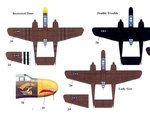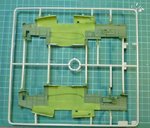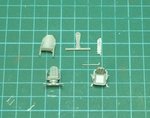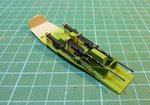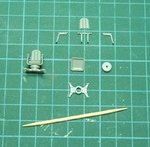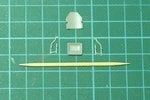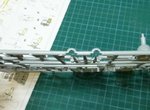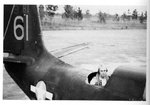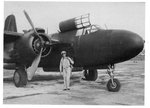- Thread starter
- #41
ozhawk40
Master Sergeant
Thanks Bill - certainly does.
The dash 2 specs are below, which means all three types were used, yellow zc, green zc and Northrop Cockpit Green were used.
E&M Manual specs:
'All exposed interior surfaces of the gunner's, pilot's and radio operator's compartments shall be finished with Northrop Cockpit Green (12 oz. of black camouflage enamel AAF 14109 to one gallon of zinc chromate primer Spec. No. AN-TT-P-656). This includes the seats and all other interior parts and surfaces except the instrument panels which will be dull black. Interior surfaces visible from the exterior shall be finished with one coat of dull enamel, AAF Spec. No. 14109 to match exterior surfaces. All unexposed interior surfaces of the gunner's, pilot's and radio operator's compartments, as between the flooring and the crew nacelle bottom, shall be coated with zinc chromate primer only, Spec. No. AN-TT-P-656. All exposed interior surfaces and parts of the turret compartment shall be finished with two coats of darkened (yellow-green) primer, Spec. No. 3-100-I. Unexposed interior surfaces of the turret compartment shall be finished with zinc chromate primer, Spec. No. AN-TT-P-656. All interior surfaces of the cannon compartment shall be finished with two coats of darkened primer (yellow-green), Spec.No.3-100-I.'
The dash 2 specs are below, which means all three types were used, yellow zc, green zc and Northrop Cockpit Green were used.
E&M Manual specs:
'All exposed interior surfaces of the gunner's, pilot's and radio operator's compartments shall be finished with Northrop Cockpit Green (12 oz. of black camouflage enamel AAF 14109 to one gallon of zinc chromate primer Spec. No. AN-TT-P-656). This includes the seats and all other interior parts and surfaces except the instrument panels which will be dull black. Interior surfaces visible from the exterior shall be finished with one coat of dull enamel, AAF Spec. No. 14109 to match exterior surfaces. All unexposed interior surfaces of the gunner's, pilot's and radio operator's compartments, as between the flooring and the crew nacelle bottom, shall be coated with zinc chromate primer only, Spec. No. AN-TT-P-656. All exposed interior surfaces and parts of the turret compartment shall be finished with two coats of darkened (yellow-green) primer, Spec. No. 3-100-I. Unexposed interior surfaces of the turret compartment shall be finished with zinc chromate primer, Spec. No. AN-TT-P-656. All interior surfaces of the cannon compartment shall be finished with two coats of darkened primer (yellow-green), Spec.No.3-100-I.'


